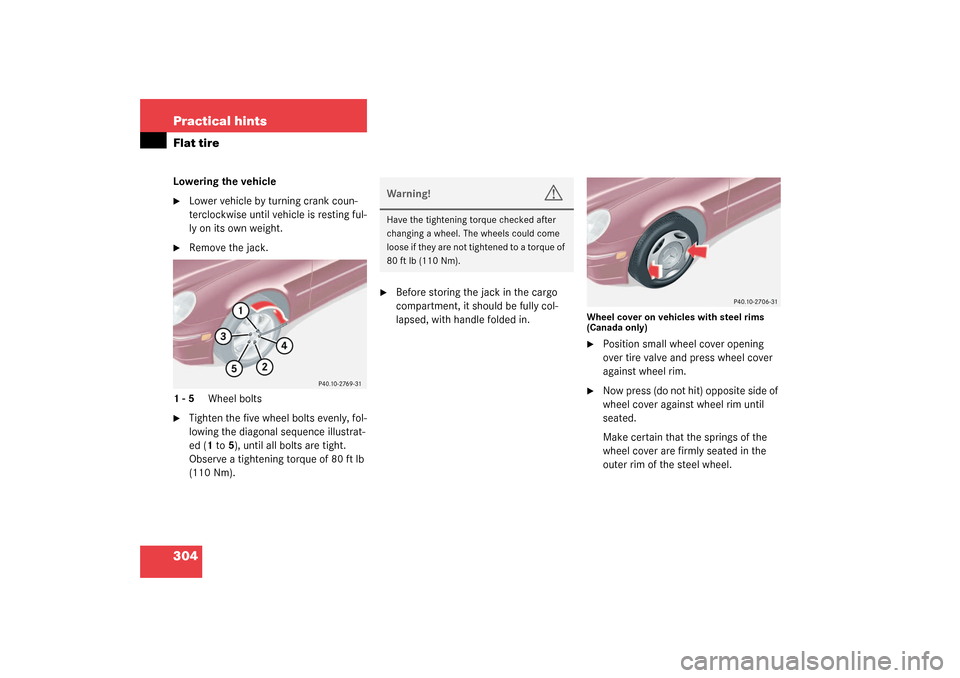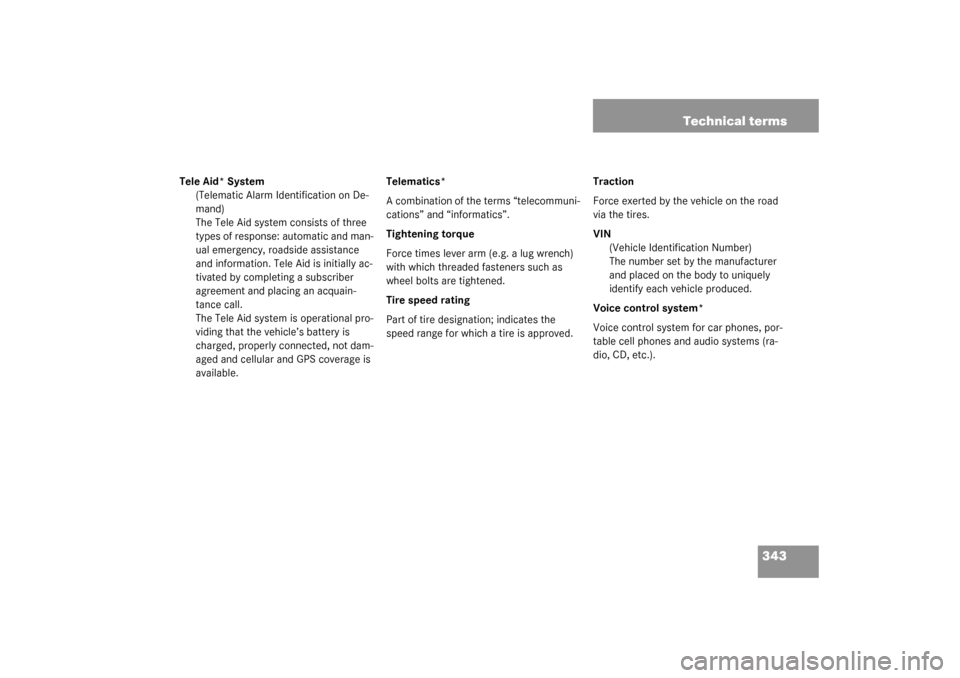Page 237 of 370

243 Operation
Tires and wheels
Tire pressure changes by approximately
1.5 psi (0.1 bar) per 18°F (10°C) of air
temperature change. Keep this in mind
when checking tire pressure where the
temperature is different from the outside
temperature.
The tire temperature and with it the tire
pressure is increased also while driving,
depending on the driving speed and the
tire load.Check the spare tire periodically for condi-
tion and inflation. Spare tire will age and
become worn over time even if never used,
and thus should be inspected and replaced
when necessary.
Rotating wheels
The wheels can be rotated every 3 000 to
6 000 miles (5 000 to 10 000 km), or soon-
er if necessary, according to the degree of
tire wear. The same direction of tire rota-
tion must be retained.
Rotate the wheels before the characteris-
tic tire wear pattern becomes visible
(shoulder wear on front wheels and tread
center wear on rear wheels).
Thoroughly clean the inner side of the
wheels after each rotation. Check and en-
sure proper tire inflation pressure.
iThe pressures listed for light loads are
minimum values offering high driving
comfort.
Increased inflation pressures listed for
heavier loads may also be used for light
loads. These higher pressures produce
favorable handling characteristics. The
ride of the vehicle, however, will be
somewhat harder. Never exceed the
max. values or inflate tires below the
min. values listed in the fuel filler flap.
Warning!
G
Follow recommended inflation pressures.
Do not overinflate tires. Overinflated tires
can result in sudden deflation (blowout) be-
cause they are more likely to become punc-
tured or damaged by road debris, potholes
etc.
Do not underinflate tires. Underinflated tires
wear unevenly, adversely affect handling
and fuel economy, and are more likely to fail
from being overheated.
Do not overload the tires by exceeding the
specified vehicle capacity weight (as indicat-
ed by the label on the pillar in the driver’s
door opening). Overloading the tires can
overheat them, possibly causing a blowout.
Warning!
G
Have the tightening torque checked after
changing a wheel. Wheels could become
loose if not tightened with a torque of
80 ft.lb. (110 Nm).
Use only genuine Mercedes-Benz wheel
bolts specified for your vehicle's rims.
S203 MY03_A.book Page 243 Tuesday, January 28, 2003 2:22 PM
Page 298 of 370

304 Practical hintsFlat tireLowering the vehicle�
Lower vehicle by turning crank coun-
terclockwise until vehicle is resting ful-
ly on its own weight.
�
Remove the jack.
1-5 Wheel bolts
�
Tighten the five wheel bolts evenly, fol-
lowing the diagonal sequence illustrat-
ed (1 to5), until all bolts are tight.
Observe a tightening torque of 80 ft lb
(110 Nm).
�
Before storing the jack in the cargo
compartment, it should be fully col-
lapsed, with handle folded in.
Wheel cover on vehicles with steel rims
(Canada only)�
Position small wheel cover opening
over tire valve and press wheel cover
against wheel rim.
�
Now press (do not hit) opposite side of
wheel cover against wheel rim until
seated.
Make certain that the springs of the
wheel cover are firmly seated in the
outer rim of the steel wheel.
Warning!
G
Have the tightening torque checked after
changing a wheel. The wheels could come
loose if they are not tightened to a torque of
80 ft lb (110 Nm).
S203 MY03_A.book Page 304 Tuesday, January 28, 2003 2:22 PM
Page 337 of 370

343 Technical terms
Tele Aid* System
(Telematic Alarm Identification on De-
mand)
The Tele Aid system consists of three
types of response: automatic and man-
ual emergency, roadside assistance
and information. Tele Aid is initially ac-
tivated by completing a subscriber
agreement and placing an acquain-
tance call.
The Tele Aid system is operational pro-
viding that the vehicle’s battery is
charged, properly connected, not dam-
aged and cellular and GPS coverage is
available.Telematics*
A combination of the terms “telecommuni-
cations” and “informatics”.
Tightening torque
Force times lever arm (e.g. a lug wrench)
with which threaded fasteners such as
wheel bolts are tightened.
Tire speed rating
Part of tire designation; indicates the
speed range for which a tire is approved.Traction
Force exerted by the vehicle on the road
via the tires.
VIN
(Vehicle Identification Number)
The number set by the manufacturer
and placed on the body to uniquely
identify each vehicle produced.
Voice control system*
Voice control system for car phones, por-
table cell phones and audio systems (ra-
dio, CD, etc.).
S203 MY03_A.book Page 343 Tuesday, January 28, 2003 2:22 PM
Page 359 of 370

365 Index
Synchronizing
Power windows 186
Sliding/pop-up roof 189
T
Tachometer 23, 105
Displaying gear range 137
Overspeed range 105
Tail lamps
Cleaning 250
Replacing bulbs 293, 297
Tailgate
Closing 87
Message in display 277
Opening 87
Tar stains 249
Technical data 330
Brake fluid 330
Coolant 328
Coolants 334
Electrical system 325
Engine 322
Engine oil 330
Engine oil additives 330
Flexible fuel vehicles 332
Fuel requirements 331
Fuels 328Gasoline additives 332
Lubricants 328
Main dimensions 326
Premium unleaded gasoline 331
Rims and tires 323
Weights 327
Windshield and headlamp washer
system 329, 336
Tele Aid* 210
Emergency calls 211
Information 214
Initiating an emergency call
manually 213
Messages in display 277
Remote door unlock 217
Roadside assistance 213
SOS button 213
Stolen vehicle tracking services 217
System self-check 211
Tele Aid* System 210
Upgrade signals 216
Tele Aid* System 343
Telematics* 343
Telephone
Emergency call 181Telephone* 24, 209
Answering a call 132
Dialing a number from the phone
book 132
Ending a call 132
Hands-free microphone 27
Loading phone book* 132
Messages in display 277
Operating 131
Operation 178
Redialing 133
Signal strength 131
Temperature
Display mode 119
Grades of tires 338
Outside temperature indicator 106
Setting interior temperature 146,
154
Setting units in display 119
Tires 243
Tie-down rings (Cargo
compartment) 202
Tightening torque (Wheel bolts) 304
S203 MY03_A.book Page 365 Tuesday, January 28, 2003 2:22 PM